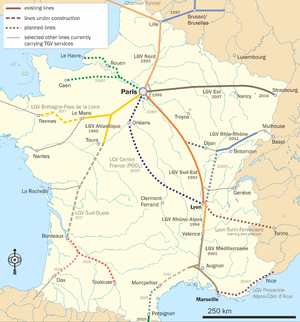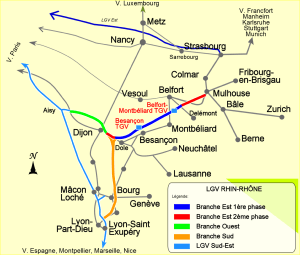LGV Rhin-Rhône
| LGV Rhin-Rhône Branche Est | ||||||||||||||||||||||||||||||||||||||||||||||||||||||||||||||||||||||||||||||||||
|---|---|---|---|---|---|---|---|---|---|---|---|---|---|---|---|---|---|---|---|---|---|---|---|---|---|---|---|---|---|---|---|---|---|---|---|---|---|---|---|---|---|---|---|---|---|---|---|---|---|---|---|---|---|---|---|---|---|---|---|---|---|---|---|---|---|---|---|---|---|---|---|---|---|---|---|---|---|---|---|---|---|---|
|
LGV Rhin-Rhône schema | ||||||||||||||||||||||||||||||||||||||||||||||||||||||||||||||||||||||||||||||||||
| Overview | ||||||||||||||||||||||||||||||||||||||||||||||||||||||||||||||||||||||||||||||||||
| Type | High-speed rail | |||||||||||||||||||||||||||||||||||||||||||||||||||||||||||||||||||||||||||||||||
| Status | Operational, partly under construction | |||||||||||||||||||||||||||||||||||||||||||||||||||||||||||||||||||||||||||||||||
| Locale | France (Burgundy, Franche-Comté) | |||||||||||||||||||||||||||||||||||||||||||||||||||||||||||||||||||||||||||||||||
| Termini |
Petit-Croix, near Mulhouse Villers-les-Pots, near Dijon | |||||||||||||||||||||||||||||||||||||||||||||||||||||||||||||||||||||||||||||||||
| Stations |
Gare de Besançon Franche-Comté TGV, Gare de Belfort - Montbéliard TGV | |||||||||||||||||||||||||||||||||||||||||||||||||||||||||||||||||||||||||||||||||
| Operation | ||||||||||||||||||||||||||||||||||||||||||||||||||||||||||||||||||||||||||||||||||
| Opened | 11 December 2011 | |||||||||||||||||||||||||||||||||||||||||||||||||||||||||||||||||||||||||||||||||
| Owner | SNCF Réseau | |||||||||||||||||||||||||||||||||||||||||||||||||||||||||||||||||||||||||||||||||
| Operator(s) | SNCF | |||||||||||||||||||||||||||||||||||||||||||||||||||||||||||||||||||||||||||||||||
| Rolling stock |
TGV Duplex TGV Sud-Est TGV Réseau TGV POS Siemens Velaro D (from 2014) | |||||||||||||||||||||||||||||||||||||||||||||||||||||||||||||||||||||||||||||||||
| Technical | ||||||||||||||||||||||||||||||||||||||||||||||||||||||||||||||||||||||||||||||||||
| Line length | 140 km (87 mi) | |||||||||||||||||||||||||||||||||||||||||||||||||||||||||||||||||||||||||||||||||
| Number of tracks | Double track | |||||||||||||||||||||||||||||||||||||||||||||||||||||||||||||||||||||||||||||||||
| Track gauge | 1,435 mm (4 ft 8 1⁄2 in) standard gauge | |||||||||||||||||||||||||||||||||||||||||||||||||||||||||||||||||||||||||||||||||
| Electrification | 25 kV 50 Hz | |||||||||||||||||||||||||||||||||||||||||||||||||||||||||||||||||||||||||||||||||
| Operating speed | 320 km/h (200 mph) | |||||||||||||||||||||||||||||||||||||||||||||||||||||||||||||||||||||||||||||||||
| ||||||||||||||||||||||||||||||||||||||||||||||||||||||||||||||||||||||||||||||||||
The LGV Rhin-Rhône (Ligne à Grande Vitesse) is a high-speed railway line, the first in France to be presented as an inter-regional route rather than a link from the provinces to Paris,[1] though it actually is used by some trains to/from Paris. The first phase of the eastern branch opened on 11 December 2011. Construction of its second phase was expected to start in 2014 but has unclear funding at this stage.
If completed, LGV Rhin-Rhône would have three branches:
- The Eastern branch, 190 km (120 mi) from Genlis, near Dijon to Lutterbach, near Mulhouse, of which 140 km (87 mi) have been built
- The Western branch, crossing Dijon, joining the LGV Sud-Est near Montbard and making the line a connection between Dijon and Paris
- The Southern branch, from Dijon to Lyon
The construction of the latter two branches and of the second phase of the Eastern branch is currently unfunded.

Running north-south, the Southern branch line would help connect Germany, the north of Switzerland, and eastern France on the one hand with the valleys of the Saône, Rhône, the Mediterranean arc and finally Catalonia on the other. The east-west Eastern and Western branches lines would help connect on the one hand London, Brussels, Lille and Île-de-France (i.e., Paris and surroundings) with Burgundy, Franche-Comté, south Alsace, southern Baden, and Switzerland on the other.
A connection will be built at Perrigny, south of Dijon, to serve TGV and freight trains. Auxon station will be connected to Besançon-Viotte station by a railway line which could be also used for commuter trains.
It is projected that 12 million passengers per year will use the LGV Rhine-Rhône service.[2]
Eastern branch
The first phase of the eastern branch runs 140 km (87 mi) of the 190 km planned length, connecting Villers-les-Pots (east of Dijon) to Petit-Croix (southeast of Belfort), was officially opened by President Nicolas Sarkozy on 8 September 2011,[3] with passenger services starting on 11 December 2011.[4]
The eastern branch is used by TGV trains operated by SNCF, the French national railway company. It will become a key link in both the North-South and East-West transport corridors. The line carries regional, national, and intra-European traffic. Mulhouse provides connection to Basel, Switzerland, and then to southwestern Germany and northwestern Switzerland.
Finance
The financing agreement for the first phase of the eastern branch was signed on 28 February 2006. The estimated cost of the first section of the eastern branch is 2.312 billion euros, shared between many organisations.[5]
The largest contributors of funds are the Government of France (€751 million), the maintainer of the French rail network RFF (€642 million) and the European Union (€200 million).[3] Significant funding also came from the three regions of France that the line travels through: Franche-Comté (€316 million), Alsace (€206 million) and Burgundy (€131 million). A further €66 million was funded by the Government of Switzerland.[3]
Construction
Preparatory works began in 2005, and construction officially started on 3 July 2006 with a ceremony in Les Magny, Haute-Saône. Actual construction of the first section started north of Besançon on 7 August 2006.
Réseau Ferré de France appointed French engineering and consulting companies Setec and Egis to build the line. The construction of the Eastern branch was divided into two sections :
- The first section is 140 km (87 mi) long, running from Villers-les-Pots, Côte-d'Or (east of Dijon) to Petit-Croix, Territoire de Belfort (east of Belfort). This section opened for service on 11 December 2011.[6]
- The second section, for which construction was initially planned to begin in 2014 but is not funded yet, would a add 50 km (31 mi) length to the line. This section would complete the eastern branch from Villers-les-Pots to Dijon, Côte-d'Or, with 15 km (9.3 mi) in the west, and from Petit-Croix to Mulhouse, Haut-Rhin, with 35 km (22 mi) in the east.
Journey times
Upon completion of the first section of the eastern branch, best journey time are:[7]
| from | to | before | after |
|---|---|---|---|
| Dijon | Strasbourg | 3h25 | 2h00 |
| Dijon | Frankfurt | 6h30 | 3h40 |
| Besançon | Marseille | 4h15 | 4h00 |
| Belfort-Montbéliard TGV | Paris | 3h25 from Belfort 3h40 from Montbéliard | 2h25 |
| Strasbourg | Lyon | 4h45 | 3h35 |
See also
References
- ↑ Murray Hughes (5 September 2007). "Inter-regional TGV line will have an international impact". Railway Gazette International.
- ↑ Railway Gazette, Presidential opening for LGV Rhin-Rhône, 8 september 2011.
- 1 2 3 "Presidential opening for LGV Rhin-Rhône". Railway Gazette International. 8 September 2011.
- ↑ "LGV Rhin-Rhône opens". Railway Gazette International. 12 December 2011.
- ↑ Ministry of Ecology, Sustainable Development, Transport and Housing, Le financement de l'infrastructure, consulted 28 December 2007
- ↑ "Inauguration of the TGV Rhine-Rhone high speed line". UIC eNews Nr 254. International Union of Railways. 9 September 2011.
- ↑ "Présentation de la LGV Rhin-Rhône". Ministry of Ecology, Sustainable Development, Transport and Housing. 1 June 2007. Retrieved 29 November 2011.
External links
- Ligne à Grande Vitesse Rhin-Rhône
- Association Trans-Europe TGV Rhin-Rhône Méditerranée
- RFF
- Inter-regional TGV line will have an international impact Murray Hughes, Railway Gazette International
